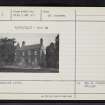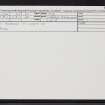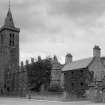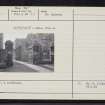St Andrews, 71 North Street
House (15th Century), Office (Period Unassigned)
Site Name St Andrews, 71 North Street
Classification House (15th Century), Office (Period Unassigned)
Alternative Name(s) University Offices
Canmore ID 34305
Site Number NO51NW 21
NGR NO 51024 16837
Datum OSGB36 - NGR
Permalink http://canmore.org.uk/site/34305
- Council Fife
- Parish St Andrews And St Leonards
- Former Region Fife
- Former District North East Fife
- Former County Fife
NO51NW 21 51024 16837
(NO 5102 1684) No.71 North Street "which stands at the eastern end of St Salvator's Church (NO51NW 10) and is now part of the University offices, seems to date from the early 16th century but many alterations were made on the fabric in the century following. It is L-shaped on plan and three storeys in height. The most interesting feature left is the little circular tower projecting from the SW angle, which was apparently a stair tower. In pre-Reformation times this house belonged to the Hospitallers or Knights of St John. Traditionally it is associated with Queen Mary. In 1572 it was acquired by the Protestant archbishop, Patrick Adamson (D H Fleming 1881)".
RCAHMS 1933
This is a small unpretentious building, which has been considerably restored, and is as described above.
Visited by OS (JLD) 17 October 1956
As described above.
Visited by OS (WDJ) 28 May 1964
NO51NW 21 51024 16837
ARCHITECT: David Henry, 1912, additions
Reginald Fairlie, 1938, Gate to (old) University Offices
REFERENCE:
ST ANDREWS UNIVERSITY LIBRARY
Plans: UY/1381
For further details please see copy of catalogue to St Andrews University Library plans in NMRS
Field Visit (24 June 1926)
NORTH STREET. - No. 71, which stands at the eastern end of St. Salvator's Church and is now part of the University offices, seems to date from the early 16th century, but many alterations were made on the fabric in the century following. It is L-shaped on plan and three storeys in height. The most interesting feature left is the little circular tower projecting from the south-west angle, which was apparently a stair-tower, since at ground level there is an external entrance, now built up. In addition to windows, back-set and chamfered, it has loop-holes of 'keyhole' and 'dumb-bell' shape. The roof is a little stone spire provided with lucarnes. On the west wall of the house there are traces of windows of 16th-century character, but the windows in the south and east walls are not earlier than the 17th century. The western crow-steps are gableted and date from the 16th century, while those to the east are at least a century later. Internally the building has been modernised, but the staircase descending to the basement is probably of the late 17th century, while the lowest fireplace in the west gable is perhaps rather earlier. In one of the upper rooms is a door of oak. In pre-Reformation times this house belonged to the Hospitallers or Knights of St. John. Traditionally, it is associated with Queen Mary. In 1572 it was acquired by the Protestant archbishop, Patrick Adamson (1).
RCAHMS 1933, visited 24 June 1926.
(1) Handbook of St. Andrews, Hay Fleming, p. 50 (note).
















